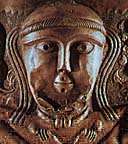 "Many of the ancient peoples of Europe marked the end of the harvest season and the beginning of winter by celebrating a holiday in late autumn. The most important of these holidays to influence later Halloween customs was Samhain, a holiday observed by the ancient Celts. Among the Celts, Samhain marked the end of one year and the beginning of the next.
"Many of the ancient peoples of Europe marked the end of the harvest season and the beginning of winter by celebrating a holiday in late autumn. The most important of these holidays to influence later Halloween customs was Samhain, a holiday observed by the ancient Celts. Among the Celts, Samhain marked the end of one year and the beginning of the next.
Samhain began at sundown on October 31 and extended into the following day. According to the Celtic pagan religion, known as Druidism, the spirits of those who had died in the preceding year roamed the earth on Samhain. The Celts sought to ward off these spirits with offerings of food and drink. The Celts also built bonfires and performed rituals, often involving sacrifices.
By the end of the 1st century AD, the Roman Empire had conquered most of the Celtic lands. In the process of incorporating the Celts into their empire, the Romans adapted and absorbed some of their traditions as part of their own pagan and Catholic religious observances.
Celtic influences lingered a long time in the western fringes of Europe and Samhain was abandoned only when the local people converted to Christianity during the early Middle Ages. The Roman Catholic Church often incorporated modified versions of older religious traditions in order to win converts. An example is when Pope Gregory IV sought to replace Samhain with All Saints’ Day in 835. All Souls’ Day, closer in spirit to Samhain and modern Halloween, was first instituted at a French monastery in 998 and spread quickly across Europe. Folk observances linked to these Christian holidays, including Halloween, thus preserved many ancient Celtic customs associated with Samhain."
See article.
 Clive Owen will be seen as King Arthur in Disney's big-budget adaptation from director Antoine Fuqua and producer Jerry Bruckheimer.
Clive Owen will be seen as King Arthur in Disney's big-budget adaptation from director Antoine Fuqua and producer Jerry Bruckheimer.
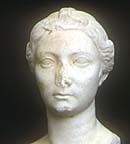 by Mary McHUGH
by Mary McHUGH
 By Alexa Jervis
By Alexa Jervis
 by Emily Albu
by Emily Albu
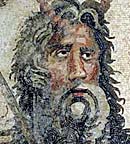 Last night I watched another program on the last-minute excavations at Zeugma. I had seen one earlier but I think this one was different. Of course, I love beautiful mosaics and the mosaics uncovered at Zeugma were some of the most beautiful I have ever seen. In fact, when it showed a computer recreation of the triclinium, I wondered how anyone could concentrate on their meal with such a breathtaking colorful mosaic on the floor.
Last night I watched another program on the last-minute excavations at Zeugma. I had seen one earlier but I think this one was different. Of course, I love beautiful mosaics and the mosaics uncovered at Zeugma were some of the most beautiful I have ever seen. In fact, when it showed a computer recreation of the triclinium, I wondered how anyone could concentrate on their meal with such a breathtaking colorful mosaic on the floor.
 "Suetonius chose a position in a defile, with a wood behind him," explains military historian Martin Marix Evans. "There could be no enemy, he knew, except at his front, where there was open country without cover for ambushes."
"Suetonius chose a position in a defile, with a wood behind him," explains military historian Martin Marix Evans. "There could be no enemy, he knew, except at his front, where there was open country without cover for ambushes."
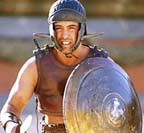 "The really sexy new history shows have been entrusted to the BBC’s Special Projects, and the BBC’s two most prestigious productions for the autumn are not drama series, nor comedies, but proud examples of their new toy: 'drama reconstruction'. It’s a genre they pioneered last year with a somewhat enervating portrayal of the construction of the Great Pyramid. If the computer graphics, sets and location filming were all groundbreaking, Pyramid was let down by concerning itself with, well, groundbreaking. Try as you might, it is difficult to make a building site exciting, even if these were the foundations for one of the wonders of the ancient world. The stilted and witless 'dramatisation' also stopped well short of arresting the attention. "
"The really sexy new history shows have been entrusted to the BBC’s Special Projects, and the BBC’s two most prestigious productions for the autumn are not drama series, nor comedies, but proud examples of their new toy: 'drama reconstruction'. It’s a genre they pioneered last year with a somewhat enervating portrayal of the construction of the Great Pyramid. If the computer graphics, sets and location filming were all groundbreaking, Pyramid was let down by concerning itself with, well, groundbreaking. Try as you might, it is difficult to make a building site exciting, even if these were the foundations for one of the wonders of the ancient world. The stilted and witless 'dramatisation' also stopped well short of arresting the attention. "
 I, too, finally got a look at Warrior Queen last night. I see what everyone was talking about in the costuming. The Roman’s armor looked like it came from a store specializing in cheap Halloween costumes and it seems like every time the Romans were the primary scene, the cinematographer turned the color setting so low they almost appeared in black and white with ghoulish white faces. Camulodunum looked like the backlot of a B-rated movie studio with cheap props scattered around a vacant lot. The attack scene made no effort to portray the ferocity of that battle.
I, too, finally got a look at Warrior Queen last night. I see what everyone was talking about in the costuming. The Roman’s armor looked like it came from a store specializing in cheap Halloween costumes and it seems like every time the Romans were the primary scene, the cinematographer turned the color setting so low they almost appeared in black and white with ghoulish white faces. Camulodunum looked like the backlot of a B-rated movie studio with cheap props scattered around a vacant lot. The attack scene made no effort to portray the ferocity of that battle.
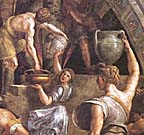 Last night I watched a "Secrets of the Dead" presentation on PBS about the great fire of Rome. I think I've seen it before but I couldn't remember. Anyway, it sounds as if Art historian Eric Varner seem to think that Nero really didn't have anything to do with it. It was just an unfortunate event that he eventually was blamed for. The narrator said that one of the reasons that archaeologists think it was not set by Nero was that it began in the poor district over by the Circus Maximus. Nero's primary support base was the poor. It was the senators that didn't support him. The program also mentioned that Nero rushed back to Rome and provided food and shelter for the thousands that were left homeless following the disaster. This does not sound like someone who would have intentionally set the fire. The program also demonstrated how the contents of the rich marble and stone villas would have provided ample fuel for the spread of the fire in the wealthier districts, especially after the fire had reached the level of a firestorm in the highly inflammable tenements of the suburra.
Last night I watched a "Secrets of the Dead" presentation on PBS about the great fire of Rome. I think I've seen it before but I couldn't remember. Anyway, it sounds as if Art historian Eric Varner seem to think that Nero really didn't have anything to do with it. It was just an unfortunate event that he eventually was blamed for. The narrator said that one of the reasons that archaeologists think it was not set by Nero was that it began in the poor district over by the Circus Maximus. Nero's primary support base was the poor. It was the senators that didn't support him. The program also mentioned that Nero rushed back to Rome and provided food and shelter for the thousands that were left homeless following the disaster. This does not sound like someone who would have intentionally set the fire. The program also demonstrated how the contents of the rich marble and stone villas would have provided ample fuel for the spread of the fire in the wealthier districts, especially after the fire had reached the level of a firestorm in the highly inflammable tenements of the suburra.
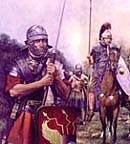 "In the late fourth century A.D., a citizen of the Roman Empire wrote a treatise known to history as De Rebus Bellicis (On Matters of Warfare). The author, whose name is unknown, offered dramatic proposals for inventions and reforms to shore up the Empire's defense. The manuscript was addressed to the highest level: the Emperor himself.
"In the late fourth century A.D., a citizen of the Roman Empire wrote a treatise known to history as De Rebus Bellicis (On Matters of Warfare). The author, whose name is unknown, offered dramatic proposals for inventions and reforms to shore up the Empire's defense. The manuscript was addressed to the highest level: the Emperor himself.
 C.J. Silverio, a software engineer in Menlo Park says author Richard Condon plagiarized "I, Claudius" in his famous novel "The Manchurian Candidate.
C.J. Silverio, a software engineer in Menlo Park says author Richard Condon plagiarized "I, Claudius" in his famous novel "The Manchurian Candidate.